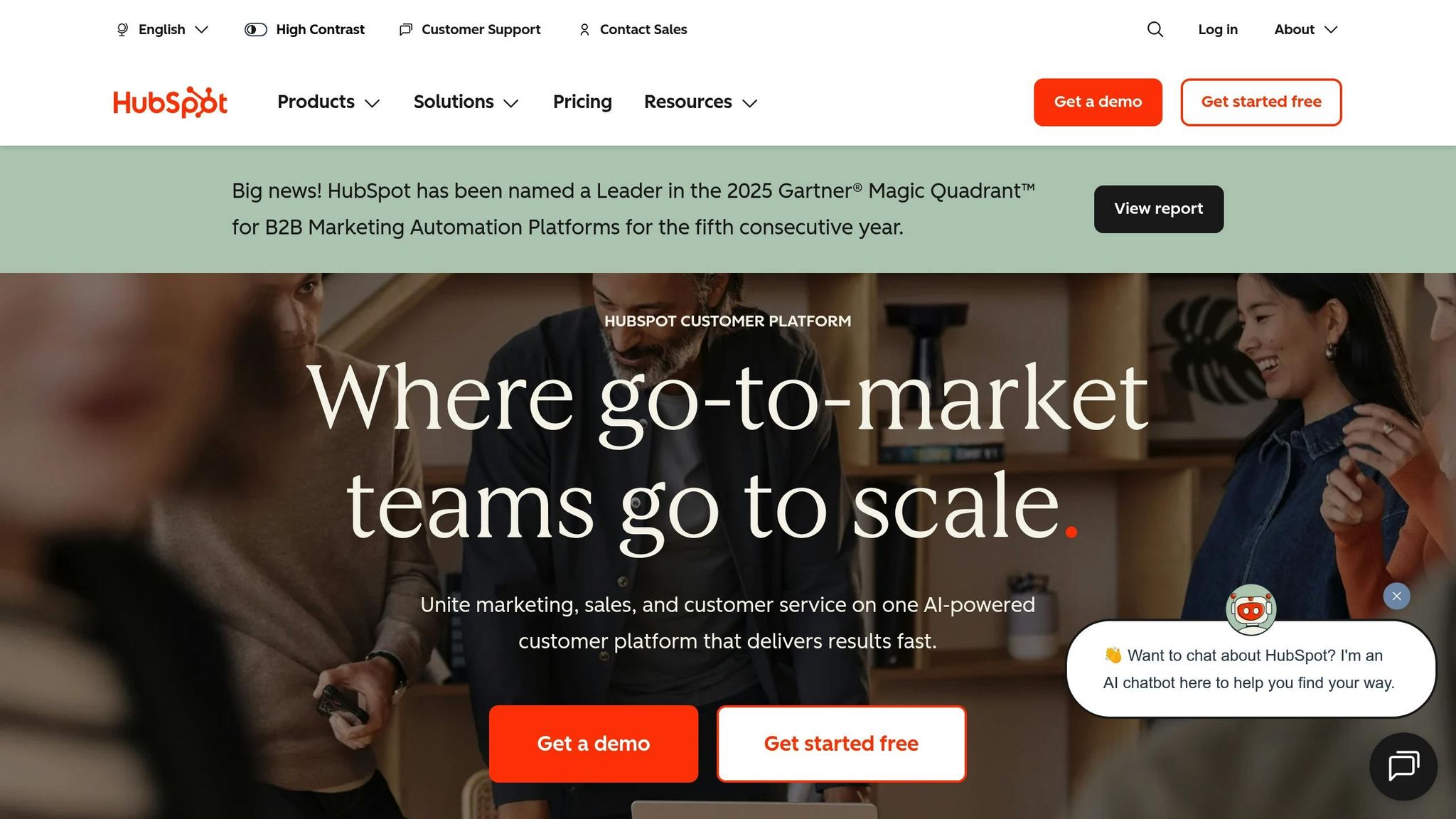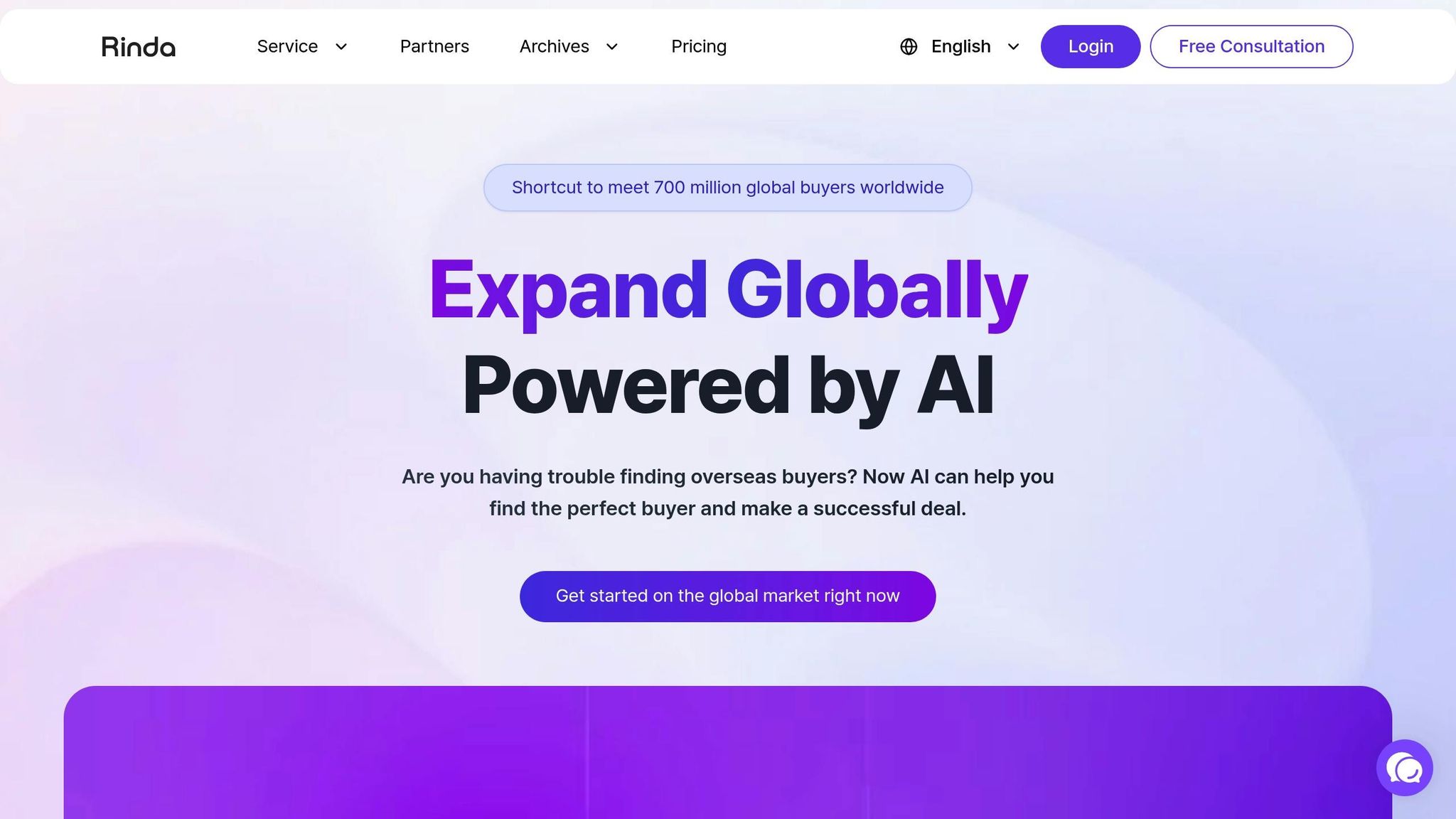Study Reveals: AI-Powered Sales Teams Achieve 25% Higher Revenue Growth in 2025
AI-driven sales teams are achieving 25% higher revenue growth by optimizing lead generation, outreach, and buyer engagement strategies.

AI is reshaping how businesses approach sales, and the numbers prove it. According to recent findings, sales teams leveraging AI tools experienced a 25% increase in revenue growth compared to those using traditional methods. This shift underscores how data-driven strategies are becoming essential for staying competitive in 2025.
In this article, you'll discover:
- How AI optimizes lead generation to focus efforts on high-potential prospects.
- The role of predictive analytics in identifying buyer intent and timing outreach effectively.
- Practical steps for integrating AI into existing sales systems without disrupting workflows.
As businesses face increasing pressure to boost efficiency and meet customer expectations, adopting AI is no longer optional. The time to act is now - read on to learn how your team can capitalize on these tools to drive revenue growth and outperform competitors.
How to Use AI to Drive Revenue Growth in 2025 | HubSpot User Group

How AI Increases Revenue for Sales Teams
AI empowers sales teams to increase revenue by leveraging real-time data to uncover opportunities, engage prospects more effectively, and close deals faster. Let’s explore how these capabilities translate into measurable revenue gains.
Automated Lead Finding and Screening
AI transforms lead generation by sifting through vast amounts of data to identify prospects with the highest likelihood of converting. It continuously analyzes signals like company trends and online behaviors to update lead scores and highlight the most promising opportunities. This ensures sales teams focus their efforts on leads with the greatest potential, maximizing efficiency and results.
Custom Outreach and Campaign Automation
AI takes personalization to the next level, crafting tailored messages that address specific business needs and industry trends. It coordinates outreach across multiple channels - email, social media, and follow-ups - streamlining the sales process. By analyzing context and tone, AI systems make conversations more meaningful and engagement strategies more effective, ultimately driving faster results.
Predictive Analytics for Buyer Intent
Predictive analytics is a standout feature of AI, offering valuable insights into buyer behavior. By interpreting digital interaction patterns, AI forecasts the best times to engage prospects and identifies potential obstacles. This precise timing and strategic approach to outreach not only improve efficiency but have also been linked to a 25% increase in revenue. Continuous monitoring of buyer intent ensures that high-interest opportunities are never missed.
Multi-Language Communication for Global Markets
AI-powered translation tools break down language barriers, enabling sales teams to connect with international prospects seamlessly. These tools go beyond basic translation by tailoring messages to fit local business practices and cultural norms. Sales representatives can confidently conduct meetings and presentations in multiple languages, expanding their reach and building stronger relationships with global clients.
Real-Time Performance Data and Feedback
Real-time analytics provide sales teams with actionable insights to refine their strategies. By monitoring key performance indicators - like email open rates, response times, and deal progress - AI helps identify areas for improvement and allows teams to make quick adjustments. This continuous feedback loop ensures that sales tactics remain effective and aligned with revenue goals.
RINDA's AI-Powered Solutions for Sales Teams

RINDA offers a cutting-edge AI-driven platform designed to transform traditional sales processes into streamlined, revenue-generating workflows. By automating the offline sales process - from identifying potential buyers to closing deals - RINDA integrates advanced AI tools to uncover leads, verify their reliability, and craft personalized outreach strategies that account for regional practices and norms.
These capabilities form the backbone of RINDA's core features, enabling sales teams to achieve measurable growth in revenue.
Core Features That Drive Revenue Growth
RINDA’s AI-powered buyer discovery engine scans global markets in real time, analyzing digital behaviors to identify prospects with the highest likelihood of conversion. This ensures sales teams can focus their efforts on the most promising leads.
The platform also performs automatic credibility checks, allowing teams to target verified, financially sound prospects. This not only shortens sales cycles but also improves conversion rates. Additionally, real-time buyer interest verification connects sales teams with prospects actively seeking solutions, supporting predictive outreach strategies that have been shown to drive a 25% increase in revenue.
With multilingual communication capabilities spanning over 20 languages, RINDA enables seamless engagement with prospects in their native language. This feature is especially beneficial for U.S.-based businesses looking to expand into European, Asian, and Latin American markets.
Business Results Delivered by RINDA
RINDA’s robust features translate into tangible business results by streamlining lead generation and enhancing outreach effectiveness. Its AI-driven lead matching technology ensures sales teams are connected with prospects that closely align with their ideal customer profiles, reducing time wasted on unqualified leads.
The platform’s AI-powered email creation tool generates personalized messages tailored to address specific business challenges and industry trends. This approach leads to higher email open rates and more meaningful interactions. Furthermore, built-in email performance analytics provide actionable insights, allowing teams to refine their messaging and outreach strategies continuously.
By learning from past successes, RINDA’s adaptive strategy improvement ensures that sales teams can maintain and build upon their performance gains, contributing to the documented 25% revenue boost achieved through AI-powered operations.
Designed for U.S.-Based and International Teams
RINDA’s pricing options cater to the diverse needs of U.S. businesses, from startups exploring international markets to established enterprises scaling global operations. The Starter plan, priced at $32 per month (billed annually), offers essential lead research tools. For active sales teams, the Standard plan, at $120 per month, includes a comprehensive suite of sales automation features.
Larger organizations can benefit from the Enterprise plan, which provides unlimited access and dedicated support for high-volume sales operations. For global teams, the All‑in‑One plan is available at ₩798,000 per month (approximately $610 per team) and includes expert global sales support alongside the AI platform.
RINDA adheres to U.S. data privacy regulations while supporting international operations, making it a reliable choice for both domestic and global teams. Higher-tier plans also include expert consultation and dedicated account management, helping businesses achieve consistent growth and operational success.
Measured Results: AI's Real Impact on Revenue
Apollo.io's 2025 study highlights a striking 25% revenue growth attributed to the adoption of AI in sales operations. This growth isn't limited to just financial outcomes - it also redefines team performance, showcasing a clear advantage over traditional sales approaches.
Comparison: AI-Powered vs. Standard Sales Teams
The study underscores that sales teams using AI-powered tools consistently outperform those relying on conventional methods. By leveraging data-driven insights and automating repetitive tasks, these teams can pinpoint opportunities with greater precision and engage prospects more effectively. These results emphasize how AI-driven processes are reshaping sales performance.
Other Metrics That Show ROI
AI's benefits extend beyond revenue growth. Companies embracing AI report significant gains in operational efficiency. Automation simplifies workflows, accurate lead targeting reduces acquisition costs, and streamlined outreach accelerates results. Many organizations see these improvements within months, underscoring the value of AI-powered sales strategies in driving both efficiency and measurable returns.
Implementing AI for Sales: What to Consider
AI has proven to be a game-changer for boosting revenue, with studies showing a potential 25% increase when implemented effectively. However, achieving these results requires a well-thought-out strategy. Rushing into AI adoption without proper planning can lead to integration problems, legal complications, and resistance from your team. To ensure success, it’s essential to tackle technical, legal, and human aspects methodically.
Businesses that see the most success with AI in sales dedicate time upfront to prepare. This includes evaluating existing systems, establishing compliance measures, and creating robust training programs. The effort invested during this phase often results in smoother implementation and faster returns. Below, we’ll explore the key factors to keep in mind when integrating AI into your sales operations.
Working with Current Sales Tools
Modern AI sales tools are designed to complement existing CRM systems and sales infrastructure, minimizing disruption. Many popular CRM platforms now include built-in API connections, allowing AI tools to sync data in real time. This ensures that workflows remain uninterrupted, making the transition easier for your team.
To integrate AI effectively, focus on connecting databases, mapping fields, and automating data synchronization. For example, AI can enhance lead scoring, outreach efforts, and predictive analytics without requiring a complete overhaul of your current systems. The goal is to select AI solutions that enhance your existing tools, allowing your team to build on proven processes while benefiting from new capabilities. Maintaining familiar workflows can significantly speed up adoption and reduce resistance compared to replacing systems entirely.
Legal Requirements and Data Privacy
When deploying AI in sales, compliance with data protection laws is non-negotiable. This is especially critical when handling customer data across multiple regions. In the U.S., regulations like the CAN-SPAM Act must be adhered to, while international frameworks such as GDPR (Europe) and CCPA (California) also come into play.
For global sales teams, data residency requirements can add another layer of complexity. Many AI platforms now offer region-specific data storage options to help businesses meet these requirements. Before rolling out AI tools, establish clear data governance policies. These should include obtaining explicit customer consent for AI-driven communications, setting up automated decision-making protocols, and conducting regular compliance audits. Training your team on proper data handling procedures is equally important. Beyond legal compliance, these measures build customer trust, which ultimately supports sustainable revenue growth.
Team Training and Change Management
No matter how advanced the technology, its success hinges on your team’s ability to use it effectively. Training programs should focus on practical applications, showing how AI insights can improve prospect conversations and boost closing rates. The goal is to make AI tools accessible and relevant to everyday sales activities.
Once the technical and regulatory groundwork is laid, shift your attention to preparing your team. Sales managers play a pivotal role in helping team members interpret AI-generated insights and integrate them into their workflows. Businesses that provide comprehensive change management support tend to see higher adoption rates compared to those that rely solely on technical training.
One common hurdle is resistance stemming from concerns about job security. Address these fears openly by positioning AI as a tool to empower, not replace, your team. Transparent communication about AI’s role can help transform skepticism into support, turning hesitant employees into advocates for its continued use and expansion. With the right training and communication, your team can fully embrace the benefits AI brings to the table.
Conclusion: Achieving AI-Driven Sales Growth
AI-powered sales teams are reshaping revenue generation, delivering results that clearly outpace traditional approaches. This shift is transforming sales performance, driving measurable outcomes, and creating advantages that grow stronger over time.
Achieving success in this space requires both thoughtful planning and effective execution. Core strategies include automated lead screening, which allows sales teams to zero in on high-potential prospects, and predictive analytics, which pinpoints the best moments to engage buyers. Additionally, customized outreach automation ensures consistent, scalable messaging, while real-time performance insights enable teams to continuously fine-tune their approach.
That said, technology alone isn't enough. Companies that see the greatest success take a deliberate approach to AI adoption. They focus on seamless integration with existing CRM systems, ensure compliance with data privacy standards, and prioritize comprehensive team training and change management. These efforts help align AI tools with current workflows, creating a foundation for sustainable growth.
As AI continues to advance, the gap between AI-enabled sales teams and their traditional counterparts is expected to grow. Businesses that adopt AI now are setting themselves up for long-term success, while those that delay may find it increasingly difficult to compete. The documented gains we've seen so far are just the beginning of AI's influence on sales.
The question is no longer whether AI will transform sales but whether your organization will lead the charge or fall behind. With a clear strategy, focused execution, and ongoing optimization, AI-driven sales growth is well within reach.
FAQs
What steps can businesses take to integrate AI tools into their sales systems without disrupting existing workflows?
To seamlessly incorporate AI tools into sales systems, businesses should begin by defining their objectives and ensuring the selected AI solutions complement existing technology. Starting with small pilot projects can help teams adjust gradually, minimizing disruptions and offering valuable opportunities for feedback.
Equipping employees with continuous training and focusing on change management are key to fostering acceptance and understanding of these tools. Promoting collaboration between AI systems and sales teams strikes a balance between automation and human insight, ultimately boosting efficiency and delivering measurable outcomes.
How can sales teams ensure compliance with data privacy laws when using AI tools?
To ensure compliance with U.S. data privacy laws while integrating AI into sales processes, it's crucial to prioritize transparency. Clearly inform customers about how their data is collected, stored, and used. Adhering to federal and state regulations, such as the CCPA or HIPAA, is non-negotiable. Additionally, practice data minimization by gathering only the information essential for your business needs.
Protecting collected data with strong security measures is equally important. Implement safeguards to prevent breaches and conduct regular audits of your AI systems to identify and address any vulnerabilities. Automating compliance documentation can simplify the process of keeping up with changing privacy standards. These efforts not only mitigate legal risks but also foster customer trust, ensuring your AI strategies align with privacy expectations and ethical practices.
How does AI improve personalized sales outreach, and what effect does this have on conversion rates?
AI has reshaped personalized sales outreach by processing massive datasets to create messages and offers uniquely suited to each prospect. This approach not only grabs attention but also fosters trust and boosts engagement, ultimately leading to much higher response rates.
Studies reveal that personalized outreach can increase email open rates by 50% and drive transaction rates up by six times. Businesses using AI-powered personalization are also up to seven times more likely to hit their sales goals. By making communications more relevant and impactful, AI helps improve conversion rates and contributes directly to measurable revenue growth.
Related Blog Posts
- AI Skills Worth $18K More: How 66,000 Job Posts Are Reshaping B2B Sales Teams in 2025
- AI Sales Agents Replace 10,000+ Jobs in July - Is Your Sales Team Next?
- From Cold Calls to AI Agents: How B2B Sales Hit 82% Higher Conversions with Personalization at Scale
- From Email to AI Agents: The Evolution of B2B Sales Automation in 2025
